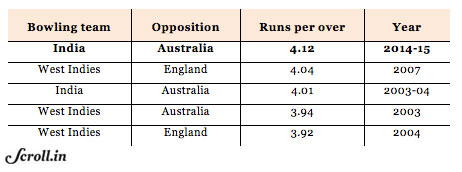Prior to the final Sydney Test in the recent Border-Gavaskar Trophy series, Kohli defended his bowlers the same way his predecessor did – by emphasising their inexperience and calling for patience with them. The patience, to be sure, has been wearing thin. The year 2014, when India played all their Test matches away from home, provided the bowlers plenty of opportunities to gain valuable experience. But scarcely did they cover themselves in glory.
In February 2014, in New Zealand, India started off well but conceded a record sixth-wicket partnership at Wellington to let the series slip away. In July-August, in England, the victory at Lord’s was overshadowed by a dismal show in the remaining matches.
The downward spiral reached a nadir in the Border-Gavaskar Test series, when India created a new record for themselves with one of their most forgettable bowling performances. The series could have been ended up as another washout for India, with a 0-4 scoreline, were it not for the doughty resistance put up the batsmen. The numbers below indicate India’s struggle overseas with the ball.
Most runs conceded in a four-Test series
Leaving aside the total runs conceded, what marked the Indian bowling's ineffectiveness in Australia was the breezy rate at which they allowed the men in Baggy Green to score runs. Below is a table of most runs conceded in an over by a team in a four-Test series. India, as it shows, have taken the top position.
Most runs conceded per over
The inexperience of the Indian side was evident in the way the bowlers went about their business in Australia. Before the beginning of the tour, there was buzz about India’s three quick bowlers – Umesh Yadav, Varun Aaron and Mohammed Shami – which eventually was belied. Though Shami was the leading wicket-taker for India with 15 scalps, he went for 4.24 runs an over. Not differently, Umesh leaked 4.62 runs per over and Aaron 5.64 runs an over.
* Australian bowlers too went for runs in the series but they conceded 3.34 runs per over.
* Of the 25 instances where a bowler went for over 100 runs in an innings, India contributed 16.
* This was the second time when four Indian bowlers gave away 100 runs or more in an innings in three consecutive Test matches. The first time was against Pakistan in 2006.
Below is a list of the teams that conceded the maximum 500+ runs in an innings in a calendar year. India, as it reveals, stands right on top with England. (Of India’s tally of six, three came in the Australia series.)
500 or more runs given away in a year
Now, even PETA has said that you can’t cosmetically remove the tail
‒ M S Dhoni
Apart from all this, what hurt India the most Down Under was their failure to seize opportunities. There were several instances where India managed to dismiss quickly the top half of Australia’s battling line-up but struggled to clean the tail. Here is the average runs conceded by a team to Batsmen 8 to 11 in 2014, a list again led by India.
Average runs conceded to the tail
It is most likely that these numbers will be forgotten when India resume playing Tests at home in 2015. Nevertheless, the realities of their weak pace attack will always stand revealed – whenever they take another trip abroad.










